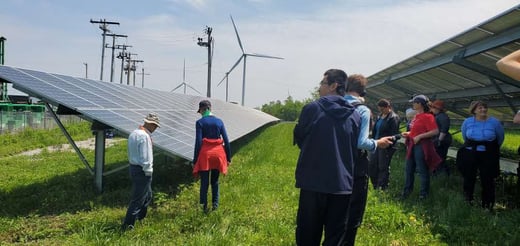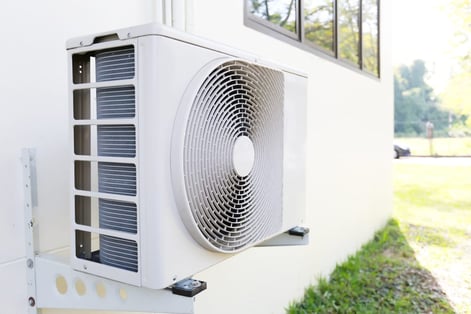The surprising overlap between heat pumps and electric cars
We at Green Energy Consumers Alliance like to connect the dots between technology, markets, and policy to help...
Decarbonizing buildings means putting an end to burning stuff in order to stay warm – whether methane, oil, or propane. The sustainable way to keep ourselves warm is through high-efficiency heat pumps (air-source or ground-source). That’s not just us talking, that’s the conclusion that Massachusetts has come to with its Clean Heat Commission report and Clean Energy and Climate Plans for 2030 and 2050. It’s also now policy for the state of New York. But this blog is not about whether we should electrify the heating sector. It’s this: People will switch to heat pumps and away from fossil fuels faster if we reduce electricity rates to make heat pumps more affordable.
Both Massachusetts and Rhode Island have had energy efficiency programs for many years that rank in the top three or four in the country, always competing with California. We’ve been saving more energy than other states, which is great because it costs less to save a kilowatt hour (kWh), a gallon of oil, or a therm of gas, than it is to buy them. We pay for those programs by putting an energy efficiency surcharge (EES) on electricity and gas. That made sense when the best we could do was to offer someone an incentive to upgrade their fossil fuel heating system to a more efficient one. But now, it’s clear we need to put our incentives to work encouraging people to skip the fossil upgrade and switch to heat pumps, which run on electricity.
If you are a customer of National Grid or Eversource in Massachusetts, look at your electricity bill and you’ll see that you’re paying over two cents per kWh for the energy efficiency program. In Rhode Island, it’s not quite as high. Again, those programs have proven themselves to have benefits that far exceed their costs. However, that’s not good enough if they perpetuate fossil fuel heating systems. Our states did not have a policy of electrifying buildings (and transportation) five years ago. We do now! Those two pennies make a heat pump or electric car less economically sensible for the consumer than they could be. And that’s counterproductive.
If states try to pay for big heat pump incentives by raising electricity rates even further, they will fail. There has to be another way.
We’re advocating for our states to establish a new policy called the Clean Heat Standard (CHS). As a brief explainer/reminder, a CHS is a “performance-based obligation” at the state level on companies that supply heat by methane, heating oil, or propane. It’s a system that would require such suppliers to deliver a gradually increasing amount of zero-emission heat each year (by, for example, helping their own or another supplier’s customers install heat pumps or insulation). These sellers of fossil fuels would have to earn “Clean Heat Credits,” which means they would be paying for what we need to decarbonize. Yes, they will try and pass that cost onto consumers of their fossil fuel products, but it would not raise the electricity rate. This is key! As a matter of fact, if we set the CHS high enough each year, we should be able to reduce the energy efficiency surcharge on everyone’s electricity rate, whether they have oil, gas, propane, or heat pumps. This shift in how we pay for heat pumps is important because it makes heat pumps a better option. We want more of what uses electricity and less of what uses gas, oil, and propane. So, let’s shift costs from the former to the latter.
New Englanders pay among the highest rates for power in America, even without the energy efficiency surcharge. And by rates, we mean three components – energy supply, transmission, and distribution. On your electricity bill, transmission and distribution are usually itemized in the delivery part of the bill, separate from the supply part. In Massachusetts and Rhode Island, all three parts are higher than elsewhere. So, we need to look closely at them.
 Lowering the supply rate
Lowering the supply rateIf you are receiving power supply from National Grid, Eversource, Unitil, or Rhode Island Energy, it’s called Basic Service and the rate is regulated by the Mass. Dept. Of Public Utilities or the Rhode Island Public Utilities Commission. Studies have shown that you are much better off with Basic Service than if you choose your own unregulated electricity supplier. We also have solid data showing that municipal aggregation is even better, so the states ought to be doing more to lift up municipal aggregation. That makes sense in a world without heat pumps and EVs, but even more when we do electrify buildings and transportation.
A principle of electricity rate-making is that the rates charged should relate to the cost of service. For example, small customers, like residents and small businesses, pay a higher rate than large customers because it costs more per kWh to serve small customers. But because we have “dumb meters” at our homes, the utility charges us the same per kWh whether we use power on a Sunday at 5 a.m. or on a Tuesday at 4 p.m. Almost always, demand on the grid is much higher on a Tuesday at 4, which means the cost of serving the customer at that time is much higher. Similarly, the utility charges us the same rate on a perfect Mother’s Day as it does during a blistering hot summer day – even though the cost of keeping us cool during a peak period is many times higher than during cooler days.
This is where advanced or “smart” meters come in. Both states will be rolling out fancy new meters in the next few years that will enable the utilities and you to know when you are using power and when you are not. In turn, that will then enable the regulators (DPU and PUC) to establish time-varying rates. Rate designs can vary quite a bit, but a simple way to put it is that rates would be higher during designated peak periods (think summer from 9 a.m. to 9 p.m.) and lower during hours that fall outside those peak periods. Guess what? Heat pumps operate during more off-peak hours than on-peak hours.
Time-varying rates don’t just benefit the consumer who uses power off-peak. By shifting demand to off-peak periods, there are savings to consumers all across the board because the infrastructure is less strained. It’s a different type of efficiency.
 We should not blithely assume that a utility’s cost of serving a heat pump customer is the same as a customer who does not have a heat pump. This requires a thorough analysis that Rhode Island and Massachusetts have not done yet. It’s important.
We should not blithely assume that a utility’s cost of serving a heat pump customer is the same as a customer who does not have a heat pump. This requires a thorough analysis that Rhode Island and Massachusetts have not done yet. It’s important.
Utilities in Maine now have special rates that consumers can opt into if they have heat pumps because Maine is trying hard to get people off heating oil. This saves the heat pump owner money in a way that is not subsidized by those who do not have heat pumps. By rejiggering the rate structure for that application, we get economic efficiency.
By the way, Maine’s regular electricity rates are significantly lower than Massachusetts and Rhode Island, to begin with. Maine is also way ahead on a per capita basis on heat pump adoption. The state has focused its energy efficiency program on getting people off oil and onto electrification and they’re having success. When we see a good idea from another state, let’s duplicate it.
The transition from fossil fuels to clean power is not going to happen through just one intervention. A good Clean Heat Standard will take us part of the way. A reformed electricity rate structure will take us further still. Add in things like all-electric new construction, a Building Performance Standard for large, existing buildings, and a Green Bank. With all that, we just might get to the greenhouse gas emissions reductions we need to treat the climate crisis like the crisis it is.
We at Green Energy Consumers Alliance like to connect the dots between technology, markets, and policy to help...
Readers of this blog should be aware that we are enthusiastic...
Comments